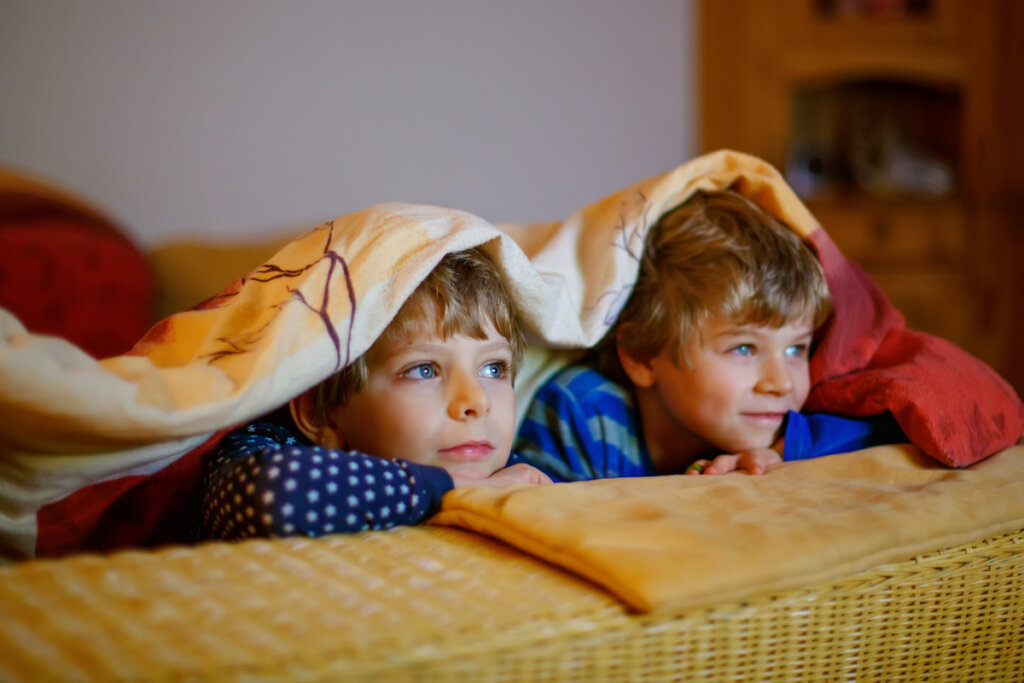The Influence of Fiction on Children


Written and verified by the psychologist Andrea Pérez
We all grew up watching certain series and movies on television that wouldn’t ever be produced today. It’s often said that they were different times. For some, they were freer. For others, more innocent. But, in reality, what appeared to be innocuous, actually influenced our education more than we could ever imagine.
As a matter of fact, from the moment we’re born, we start to learn about our surroundings. Although there’s a biological component, learning is of fundamental importance in our development. Some of our learning takes place, to a great extent, as a consequence of our interaction with the environment. It could be said that those around us form ever-changing and movable canvases. They teach us the art of living in the world.
When looking at one of these canvasses, the child sees in them the images of many people and references to learn from. They store, interpret, imitate, and internalize this information. Gradually, the figures on the canvas start to blur. And, within the frame, the silhouette of the child can be seen. As such, the child begins to see their own reflection and personality, made up of small pieces they’ve acquired from here and there.
For a long time, there’s been a tendency to think that the environment that a child uses as a reference for their learning only includes their parents, close relatives, or school friends. Although they obviously play a leading role in this process, there are also other references that hadn’t previously been considered. These are the fictional characters in children’s lives. In fact, the influence of fiction greatly affects their education.

The influence of fiction on children
There’s been a big boom in tv series and movies over the last two decades. They’ve gone from being secondary entertainment to one of the central axes of our leisure time. Moreover, they’ve become a means of communication with great power and influence. In fact, by their very nature, they’re not only part of the social culture but they also reflect it.
Therefore it’s hardly surprising that there’s some concern about what children see on the screen and the influence of fiction on their education.
Just like adults, children also identify with the characters they see on the screen. They empathize and see themselves reflected in them. Furthermore, they come to admire them and might dream of becoming them or living their lives. They imitate their gestures, expressions, and also their behaviors and make them their own. Plots often help them understand their feelings and can provoke feelings of joy, sadness, fear, repulsion, etc.
It’s often said that children are like sponges which is absolutely true. Consequently, identifying and imitating their audiovisual referents influences the construction of their systems of values and beliefs. It also helps them learn social norms.
Through this process, children begin to learn, not only about the world around them but also about themselves. They acquire self-concept and self-esteem and start to recognize the role they occupy in society.
Accompanying our children in their audiovisual consumption
It’s a good idea to preview any program your child may watch to check whether it’s suitable for them. You could also watch the show together and clarify anything they may not understand. If necessary, explain the context and deal with any doubts they may have.
Your child won’t grow up with low self-esteem by simply watching one isolated movie in which they don’t see themselves represented or via social prejudices. In fact, children’s learning is more like a house made of bricks, it doesn’t depend on one factor only.
To build the house, the child will select and stack the bricks based on the houses they see around them and those that their environment passes to them. If one of those bricks isn’t suitable, they probably won’t choose it. And, even if they do, the foundations of their house will be too solid for only one brick to affect the whole structure.
The world of cinema and television series is extremely wide. Your child may want to watch a program that you, as a parent, don’t consider to be appropriate. In this case, you’re not depriving them of freedom of choice. You can look for alternatives that meet both your expectations.

The move toward a more inclusive audiovisual experience
Through fiction, children not only imitate and internalize character behaviors but also begin to interpret the world and society around them. And, fiction provides them with a great deal of information about society and the norms that regulate it. In fact, the influence of fiction is such that it often transmits certain inequalities, stereotypes, or prejudices.
For decades, this process has been carried out mainly through invisibility. Indeed, certain people have had no presence at all on our screens. For example, those with disabilities, non-standard bodies, or different skin colors from the majority. And, when they did appear, they tended to take on roles that reinforced harmful stereotypes.
Harmful stereotypes
When we watch movies, we like to find common ground with its protagonists. We like to see ourselves physically or morally represented. The fact that situations that we’ve also experienced are portrayed helps us immerse ourselves in the storylines. The same is true for children. Their connection helps them create references that they learn from throughout their childhood. Therefore, what’s represented and how plays an important role. And, just as important is that which isn’t represented or hidden.
For example, what happens when no character represents a child’s own reality? If a black girl has never seen a character with the same skin color in positions of power on screen, she may think that she won’t be able to occupy one in the future either. Or, if a child has never seen a romantic relationship between two men on screen, they may later believe that they must hide their own sexual orientation from others. And, if an overweight girl only sees characters with similar bodies being ridiculed for their weight, she’ll normalize that behavior and come to believe that she deserves it. Finally, if a character with a physical disability is never shown acting independently on the screen, the child who shares a similar condition may come to think that they’ll never gain autonomy.
Critical capacity
Children haven’t yet formed their critical capacity. They lack sufficient training to be able to interpret the information they receive, as well as to analyze and contextualize it. For this reason, the inclusion of new plural and diverse referents on our screens allows children to normalize, not only their own realities but also those that are still foreign to them.
Plurality in fiction promotes education in childhood in equality, something from which we all benefit.
All cited sources were thoroughly reviewed by our team to ensure their quality, reliability, currency, and validity. The bibliography of this article was considered reliable and of academic or scientific accuracy.
- Palacios J; Marchesi, A; Coll,C: “Desarrollo psicológico y educación” . Psicología y Educación. Madrid: Alianza editorial
- Casas, F. (1998). Infancia: Perspectivas psicosociales. Barcelona: Paidós
- Vergara, A., Chávez, P. & Vergara, E. (2010). Televidencia y vida cotidiana de la infancia. Un estudio de casos con niños y niñas de Santiago. Polis, 26, 2-17.
This text is provided for informational purposes only and does not replace consultation with a professional. If in doubt, consult your specialist.








